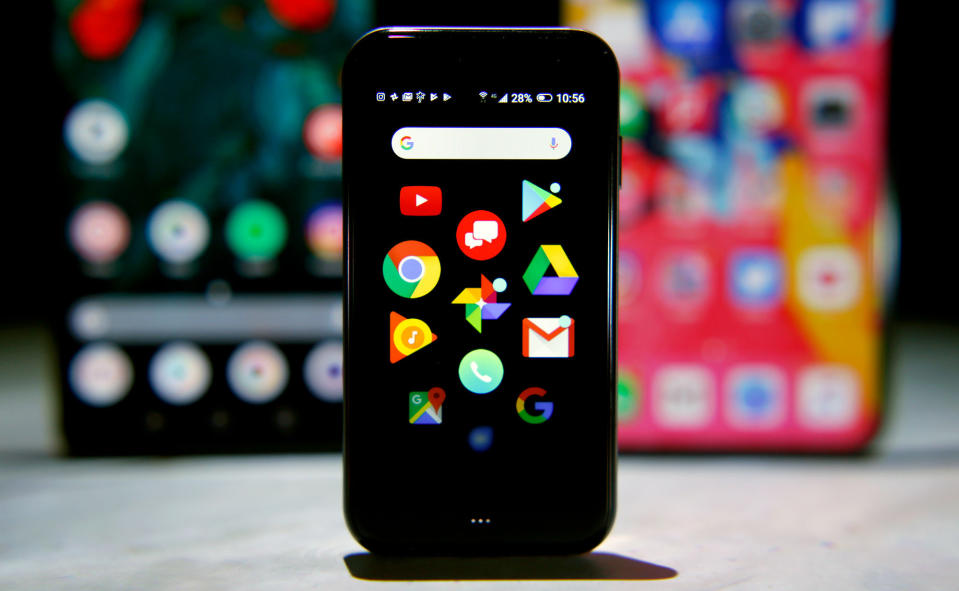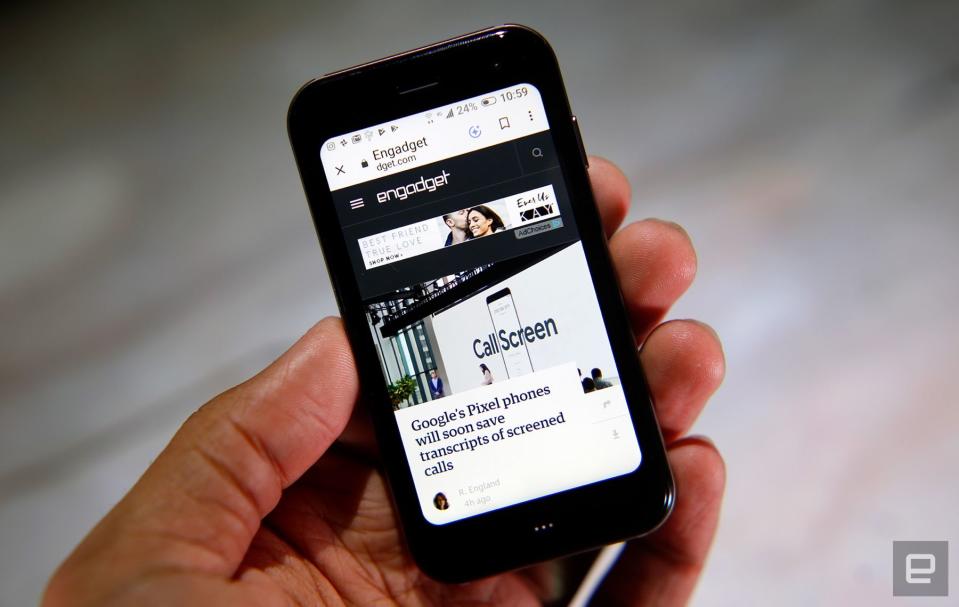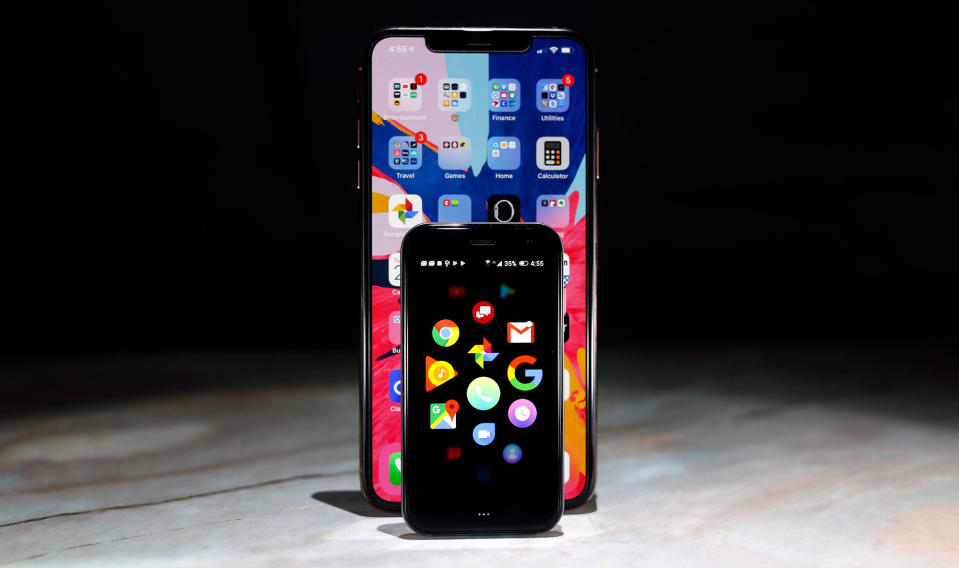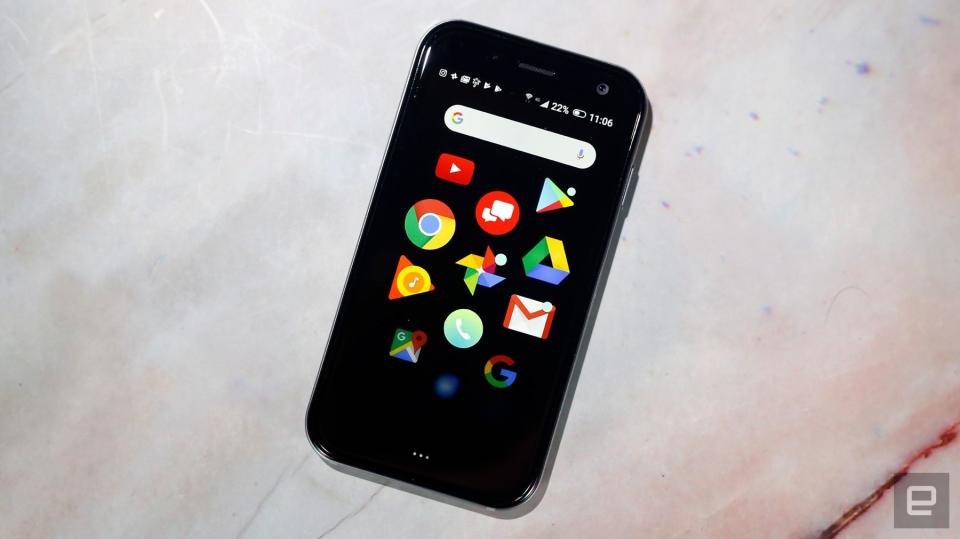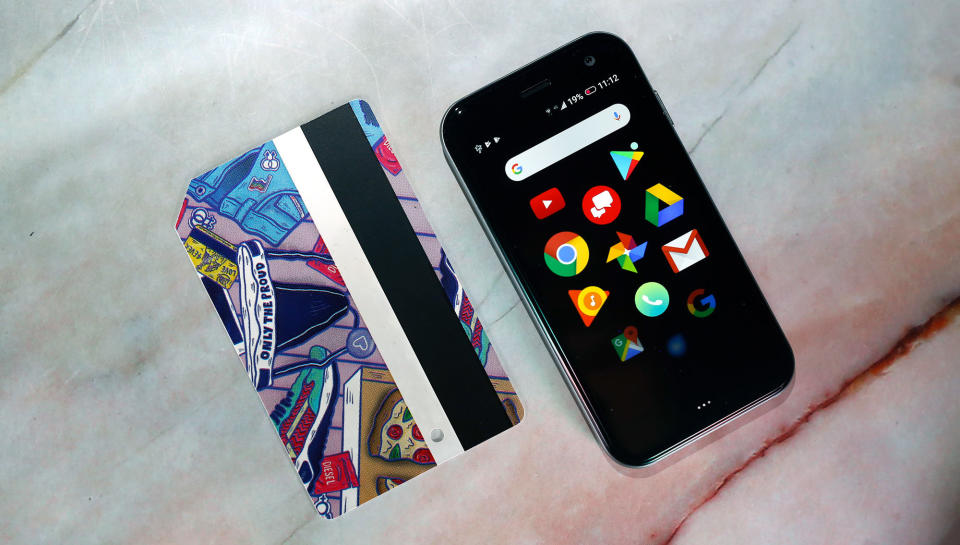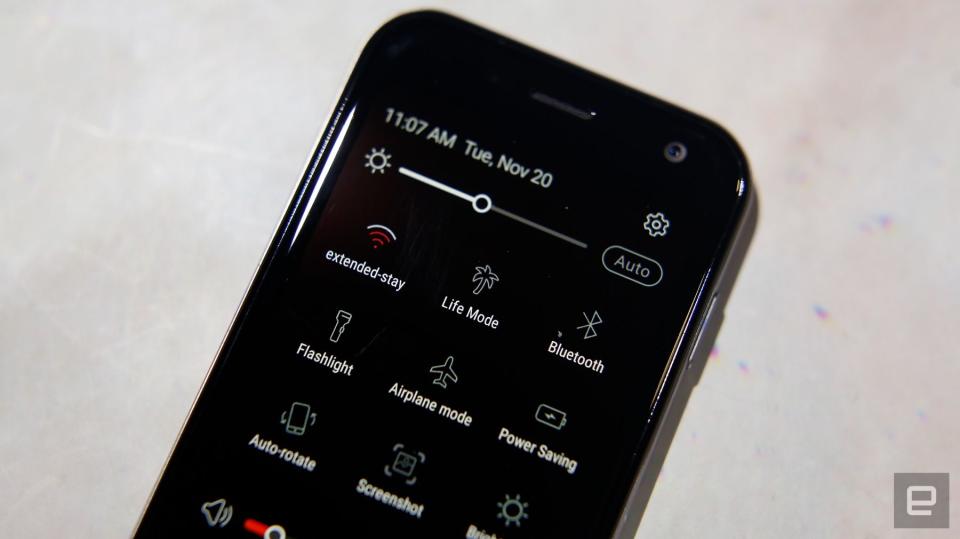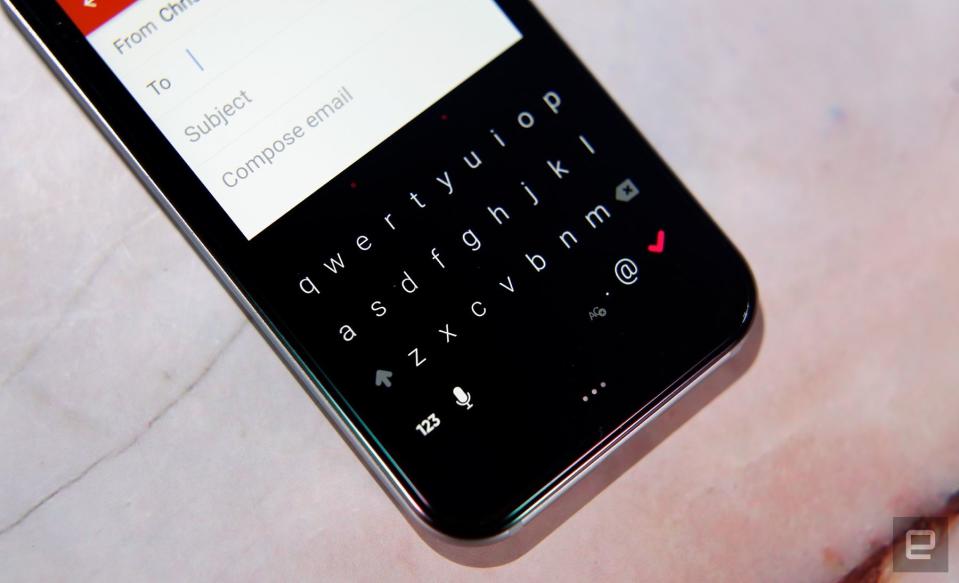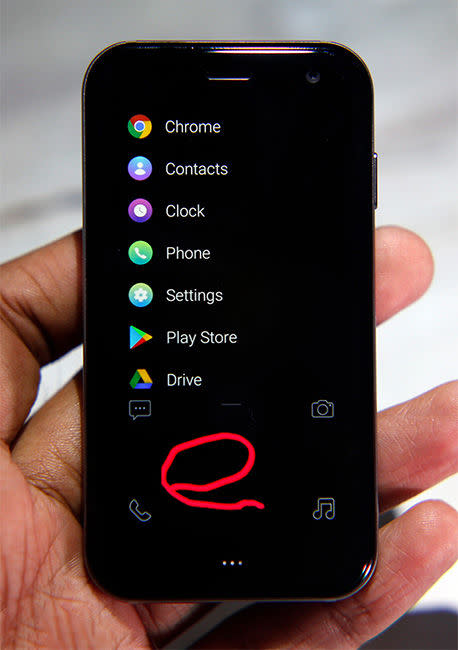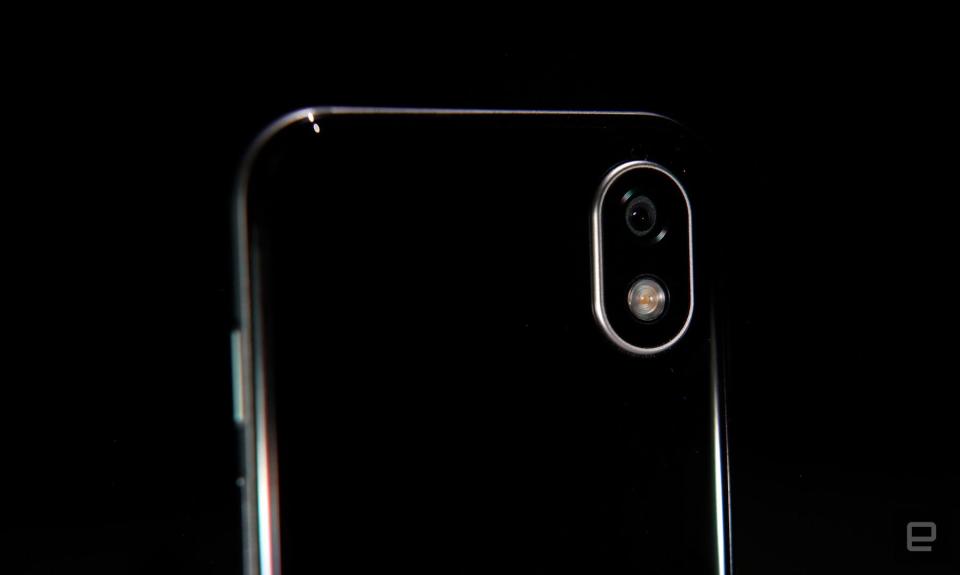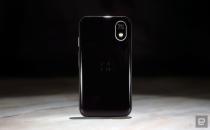Palm phone review: A tiny 'second phone' no one needs
How can something so small be such a big headache?
The only phone I've ever waited in line for in my life was the original Palm Pre. What can I say? I believed in the company's approach to design, webOS seemed to have a lot of potential and I thought the market could use some more competition. I bought in, and I was crushed when HP acquired Palm and ran webOS into the ground.
Now, years later, the Palm brand is back, and its new stewards are asking us to buy in once again. The pitch this time is highly unusual though. The company is selling a tiny, $350 Verizon-exclusive smartphone that's supposed to be a companion to your regular phone for when you want to disconnect... but not completely. There's little argument that we all probably spend too much time on our phones, and the former Samsung design execs who crafted the Palm did so to bring people out of their bubbles and back into the real world.
The problem Palm is trying to tackle is a real one, and people deserve a solution. I'm just not sure Palm's first attempt is one that'll actually work for most people. Sure, it has its charms. In most cases, though, it's such a pain to live with that you'll wish you never decided to leave your main phone at home.

The basics
So what exactly does $350 (or around $15 per month on a Verizon installment plan) actually get you? A lot of compromises packed into an admittedly adorable body. To the new Palm's credit, its first phone is actually a looker: It's a sleek rounded thing that (unintentionally) mimics the "river stone" aesthetic of the Palm Pre. And yes, it's very small: The Palm is roughly the size of a credit card, though obviously much thicker. Apart from the new, stylized Palm logo (which is easily misread as "Plam") and the noticeable 12-megapixel camera hump around back, though, the phone doesn't pack many visual flourishes. Same goes for physical controls: There's nothing here but a power button and a capacitive touch button beneath the screen. Beyond that, there's a USB-C port along the bottom edge, a SIM tray on the right side and... that's about it.
The Palm's subtle design means there's nothing to distract you from the 3.3-inch IPS LCD display. And despite only being 720p, this is actually a pretty nice little screen. Its diminutive proportions mean we're working with a pixel density of about 445PPI. That puts it in the same ballpark as devices like the iPhone XS Max. It's also plenty bright, and even with my rapidly aging garbage eyes, I never had trouble reading the Palm's tiny screen under broad daylight. For a screen this small, I'd call that a plus.
There are a few more things worth noting here. Above that screen is a minuscule 8MP camera for selfies, and there's no microSD slot, so you're stuck with the default 32GB of storage. Arguably, though, the best thing about the Palm's body is the one you can't actually see. It's rated IP68 for water and dust resistance, which may seem like overkill until you see it the way I do. After all, if there were ever a phone that I'd drunkenly drop into a beer, we're looking at it.
Oh, and one more thing to keep in mind: The Palm's unusual proportions mean it's also bound to draw a lot of attention. Of all the phones I've tested this year, from new iPhones to an ostentatiously pretty Huawei, the Palm by far made the most people do a double take and ask a bunch of questions. I'll admit it: I was a skeptic about this whole thing at first, but the number of people who said the Palm was exactly what they needed made me reconsider things. (For a while, anyway.)

Sidekick syndrome
Before we get into what the Palm is actually like to use, we need to talk about the role it's meant to play. You're supposed to carry it when you don't need the full power (or the distraction) of your main phone. A sidekick device like this can definitely feel like overkill, especially when you consider you have to pay $10 per month to use Verizon's NumberShare service to get your main phone number up and running on the Palm.
I've seen a few people remarking on the Palm's potential as a stripped-down smartphone for children, but for now that's not possible under Verizon's rules. From what I've seen, there isn't anything stopping Verizon from selling the Palm as a standalone phone; it just doesn't want to. There's a fully functional SIM slot here and you could theoretically throw an existing functional SIM into one, but Verizon won't actually sell you one for use like that.
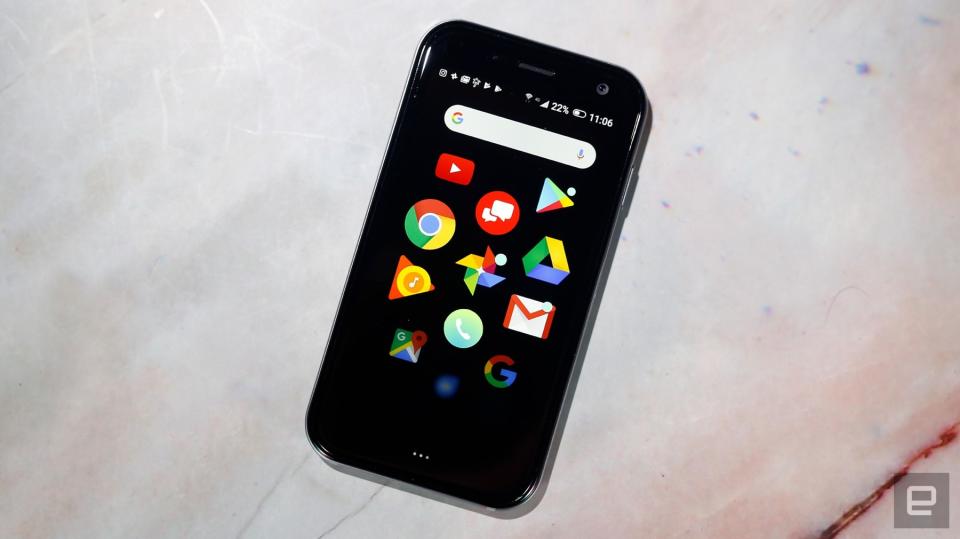
Palm and Verizon also tout the phone's compatibility with Android and iOS, but the latter is a bit misleading. Yes, you can use NumberShare to push phone calls and messages from an iPhone to a Palm, but iMessages won't appear on the Palm. Verizon recommends disabling iMessage and using its own Messages+ as your messaging app, but that's not going to fly for the vast majority of Apple users. There's also the cognitive dissonance that comes with switching between iOS and Android regularly. I can't imagine too many people would be thrilled at having to use a completely different platform (with all of its specificities and quirks) just to get a few distraction-free hours.
The Palm is similarly unfriendly to people who use apps like WhatsApp, which only allows you to be signed in on one device at a time. The app will work perfectly well once installed, but that means you'll be signed out on your primary phone. To be fair, switching service back to the original phone isn't the hardest thing to pull off, but who wants to deal with that every time you want to send a few messages from the Palm while you're out?

In use
It might look like a lightweight, but the Palm is actually more capable than you'd expect. That's mostly due to two things: the Snapdragon 435 and 3GB of RAM onboard, plus the sleek interface painted on top of Android 8.0. The 435 isn't the newest or fastest chipset in Qualcomm's arsenal, but it's enough to keep things running at a respectable clip. Sure, the Palm can be slow to launch software and it exhibits its fair share of stuttering while switching between running apps, but it's not any worse than other devices in this price range. Given that you're not supposed to use the Palm for much, I'd consider this a forgivable sin.
Meanwhile, Palm's work to make Android Oreo usable on such a small screen is impressive. The home is festooned with app icons that grow and shrink as you scroll through the grid (somewhat reminiscent of the Apple Watch). And thankfully, the phone largely relies on its single capacitive button for navigation. Rather than forcing you to use an incredibly small set of nav keys, a single tap on the button brings you back one level and a double-tap takes you back to the home screen.
Depending on how big your fingers are, though, actually using these full Android apps can be difficult. It wasn't that long ago that smartphone screens were relatively puny, but big shifts in the industry mean Android has almost completely outgrown displays like this. Trying to hit the right touch targets on-screen can sometimes feel like an exercise in madness, and you're obviously not going to want to edit your photos or watch Jack Ryan on Amazon Prime. Android as a platform is still plenty functional here, even if it's far from ideal, but the Palm sort of feels out of step with modern life.
Then again, that's the whole point. The Palm is meant to offer just enough of what you need without sucking you in for hours. With that in mind, the frustration that comes with that small screen almost seems like an asset, another tool to get off the Palm quickly.
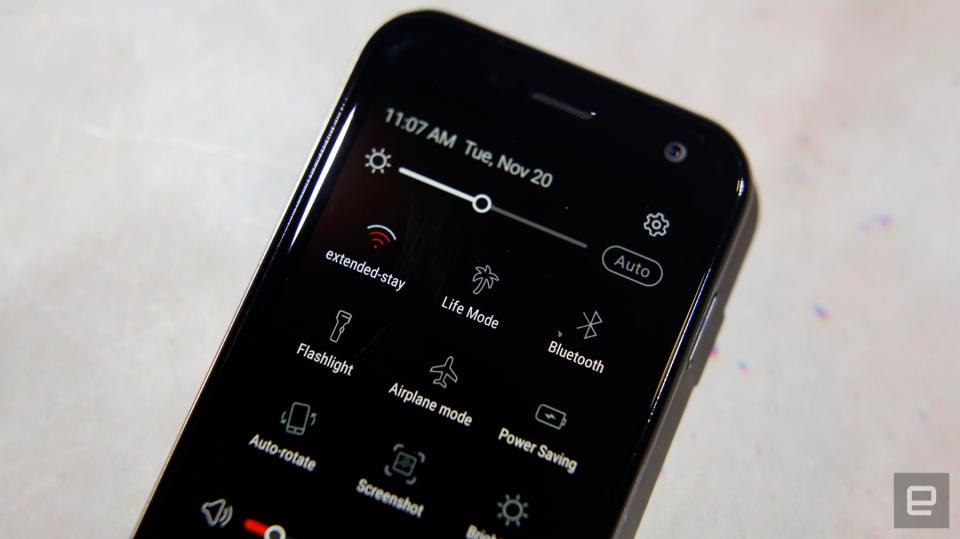
Palm has one more tool to help you stay off of your phone when you don't need it: Life Mode. It's basically Do Not Disturb on steroids. It not only prevents a distracting avalanche of notifications from rolling in but also turns off most of the Palm's wireless radios while the screen is off. (I really hope you weren't expecting an important call.) Bluetooth and GPS still work when Life Mode is enabled, so the Palm actually made for a pretty good pre-winter running companion, but honestly, it's not that much more helpful than your usual phone's DND mode.
And with that, I've pretty much run out of nice things to say. Palm made a number of weird decisions and oversights here that make using the phone a headache, some more obvious than others. Volume buttons, for instance, should be required on every smartphone. And while Palm teamed up with the people at Fleksy on a custom keyboard for this pint-size screen, the partnership hasn't led anywhere good. Punching out messages with any kind of speed and accuracy is almost impossible, and it doesn't support swiping to type, which probably would've been the most elegant solution here. You could always dictate your messages with Google Assistant, I guess, but that's not going to work in every situation. Messaging on a phone is absolutely crucial, and on the Palm, it's just terrible.

Even unlocking the Palm can be troublesome at times. In general, you'll need to rely on PINs, patterns or passwords, though you can set up Face Unlock once a primary unlock method is set. It's surprisingly fast, but since it relies solely on image data, it's not the most secure way to protect your phone. Oh, and forget about using it in the dark too.

The weirdness doesn't end there. In a nod to old-school Palm life (and I mean pre-Pre here), you can swipe up from the lock screen to see a list of your apps, shortcuts to the camera and media player, and a gesture pad where you can trace letters to find the app you're looking for. It's a bit of fan service for longtime Palm aficionados, and it sounds pretty intuitive at first. Then you start trying to use the thing and realize it's utterly half-baked.
For one, the gesture mode is only accessible from the lock screen. That isn't a problem unless you happen to have Face Unlock enabled. If that's the case, the Palm will probably see your mug and unlock itself before you even have the chance to swipe up. The irony is, after figuring out how to consistently get into that gesture search panel (usually by averting my face so the phone wouldn't prematurely unlock), the thing barely worked!
Tracing out a vertical line for the letter "I" should've brought up Instagram. Instead, the Palm usually offered a shortcut to "Recents" or nothing at all. Fair enough; maybe that's my fault. Of four attempts at drawing the capital "I" with the crossbars, the Palm correctly interpreted it once. The system recognized some letters more accurately, but c'mon: If the letter-recognition system is this hit or miss, it shouldn't even be here.
And then there are the cameras.

Really, the best thing I can say about the Palm's main 12-megapixel camera is that it exists and it, in fact, takes photos. Shots taken in well-lit environments are passable and will do in a pinch (especially after some editing in Instagram). Even with bright lighting, though, the Palm seems to have a lot of trouble focusing. Almost every photo I took of people featured a soft, fuzzy face dead center in the frame. The Palm's photos tend to get blown out a lot, and they often look hazy and indistinct. And selfies? Well, those are pretty lousy, too, though I'm more forgiving of lackluster front-facing cameras. Here's the thing though: People carry phones to snap photos as much as they do to putz around online. A secondary phone that's meant to temporarily replace your main one while you're out trying to live your life should have a better camera, period.
As you'd probably expect from a phone this small, the Palm's battery life can be problematic. The company says the phone is rated for about seven to eight hours of use, but that's only if you use the Palm in fits and starts. On the off chance that you ever sit down and use the Palm for web browsing and video streaming the way you would a typical smartphone, you'll be lucky if the battery manages to last three hours. In any other case, this would be unacceptable, but it doesn't seem fair to hold this to the same standard as other phones. Just be aware of the limitations. You could potentially get through a whole day with this thing, but only if you rely on that radio-killing Life Mode to keep you disconnected most of the time.
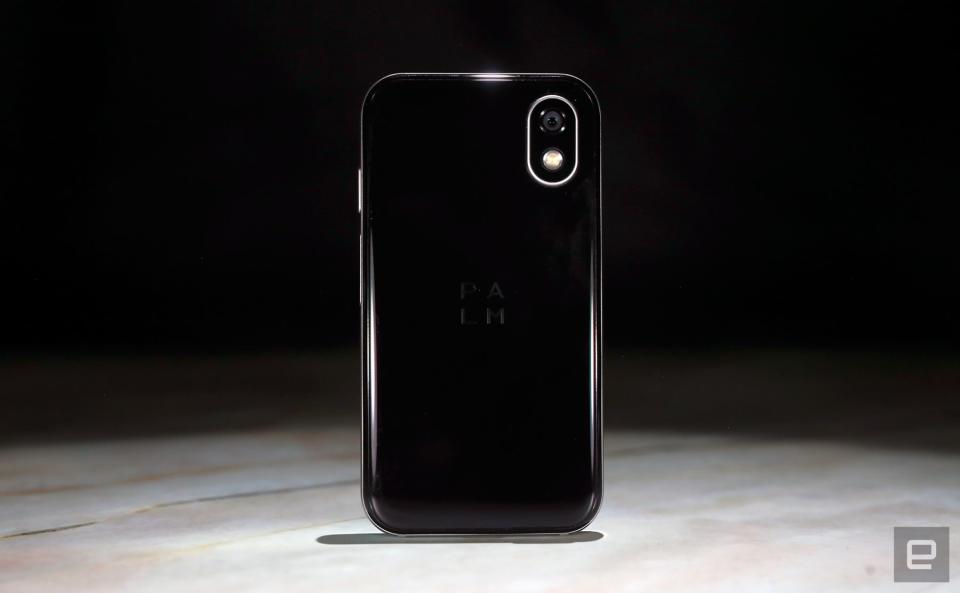
Wrap-up
As much as I wanted to love this absurd little thing, the Palm feels like a half-baked solution to a serious problem. There's an argument for actively choosing to disconnect, and using a second, more-limited phone might help some people do that. The problem is, that second device has to make the right compromises. Even a pared-down phone should give you effective tools when you need them and fade gracefully into the background when you're finished. That's where Palm fell short. The company's aims are admirable, but a phone meant to help improve the quality of your life simply shouldn't be this frustrating.


